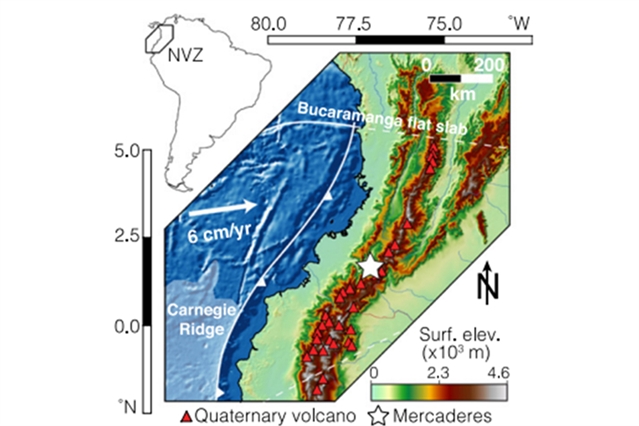
美国亚利桑那大学Lisa Zieman的团队在研究受捕虏体岩石学限制的现代安第斯山北部岛弧的热量和密度结构中取得新进展。相关论文于2023年4月19日发表在《地质学》杂志上。
研究人员利用来自哥伦比亚梅尔卡德尔斯的一套独特的下地壳和地幔捕掳体,进行直接的岩石学观测,限制了安第斯山北部火山区的那些性质。主凝灰岩中锆石的化学磨蚀同位素稀释热电离质谱(CA-ID-TIMS) U-Pb年龄表明,捕虏体的喷发不早于238年(±19)ka,因此,捕获了弧和弧下地幔的近期快照。81个捕虏体的平衡压力-温度(P-T)估计定义了三个不同的热域,解释为(1)弧下地壳中陡峭的传导性地热梯度;(2)对流地幔楔;(3)俯冲板块附近的冷却地幔。
研究结果表明,存在一个厚度为10到14km的高密度岩石圈根,其密度比下面的地幔高约0.1g/cm³。对于安第斯山北部来说,不同于挖出的古岛弧记录,利用P-T-ρ来限制的Rayleigh-Taylor不稳定性计算是不切实际的。研究团队认为在这个热弧根部存在部分熔融物是防止或显著减缓下沉的潜在浮力来源。
研究人员表示,岛弧的热结构和成分结构是影响大陆地壳演化的两个关键过程,并影响岩浆分异和下地壳的下沉。虽然基于对流下降计算,许多研究提出了岩石圈再循环的时间尺度,但这些模型取决于下地壳和地幔的成分、密度(ρ)和热结构,而且这些在活动大陆弧中难以量化。
附:英文原文
Title: To sink or not to sink: The thermal and density structure of the modern northern Andean arc constrained by xenolith petrology
Author: Lisa Zieman, Mauricio Ibanez-Mejia, Alan D. Rooney, Elias Bloch, Natalia Pardo, Blair Schoene, Dawid Szymanowski
Issue&Volume: 2023-04-19
Abstract: The thermal structure and compositional structure of arcs influence magmatic differentiation and lower-crustal foundering, two key processes impacting the evolution of the continental crust. Although many studies have proposed time scales of lithospheric recycling based on convective downwelling calculations, these models depend on the composition, density (ρ), and thermal structure of the lower crust and mantle, which are difficult to quantify in active continental arcs. Here, we constrained these properties for the Andean Northern Volcanic Zone using direct petrologic observations from a unique suite of lower-crust and mantle xenoliths from Mercaderes, Colombia. Chemical abrasionisotope dilutionthermal ionization mass spectrometry (CA-ID-TIMS) U-Pb dates for zircons within the host tuff indicate the xenoliths erupted no earlier than 238 (±19) ka and thus capture a recent snapshot of the arc and subarc mantle. Equilibrium pressure-temperature (P-T) estimates for 81 xenoliths define three distinct thermal domains, interpreted as (1) a steep conductive geothermal gradient in the lower arc crust; (2) a convecting mantle wedge; and (3) cooled mantle in proximity to the subducting slab. Our results indicate the presence of an ~10-14-km-thick, high-density lithospheric root that is ~0.1 g/cm3 denser than the underlying mantle. Unlike records from exhumed paleo-arcs, Rayleigh-Taylor instability calculations using our P-T-ρ constraints are unrealistically short for the northern Andes. We suggest the presence of partial melts in this hot arc root as a potential source of buoyancy preventing or significantly slowing down foundering.
DOI: 10.1130/G50973.1
Geology:《地质学》,创刊于1973年。隶属于美国地质学会,最新IF:6.324
官方网址:https://pubs.geoscienceworld.org/geology
投稿链接:https://geology.msubmit.net/cgi-bin/main.plex
